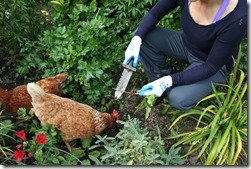 The humble trowel has taken a backseat in recent years to its sharper competitor, the hori-hori or Japanese soil knife. Because my landscaping employees lose their soil knives more often than I’d like, I’ve had a good excuse to try out all the different brands out there and get a feel for which ones perform the best, are most ergonomic and comfortable, and most importantly, which ones truly last (as long as they aren’t lost in the compost pile).
The humble trowel has taken a backseat in recent years to its sharper competitor, the hori-hori or Japanese soil knife. Because my landscaping employees lose their soil knives more often than I’d like, I’ve had a good excuse to try out all the different brands out there and get a feel for which ones perform the best, are most ergonomic and comfortable, and most importantly, which ones truly last (as long as they aren’t lost in the compost pile).
Because the world of hori-horis is constantly growing, I’ll update this post every time I test a new version.
The Best: Garret Wade Pro Gardener’s Digging Tool
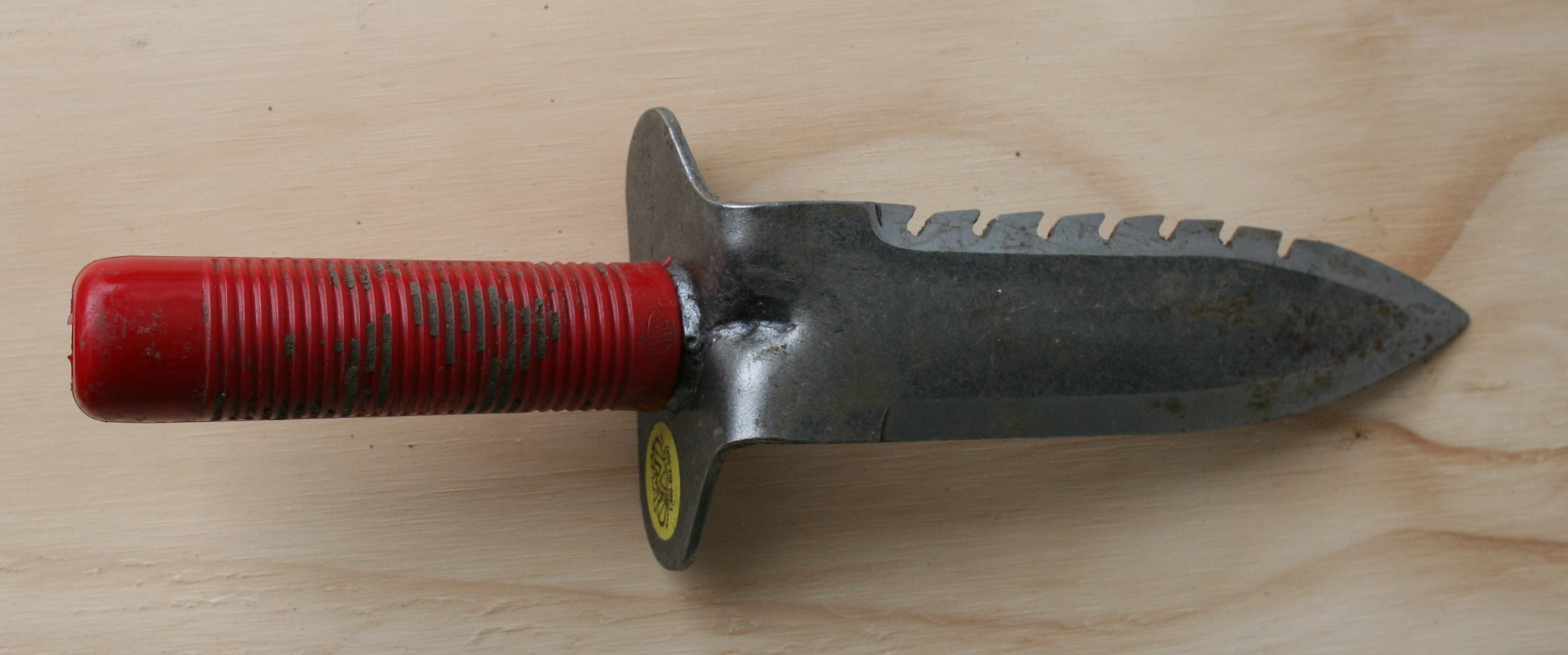
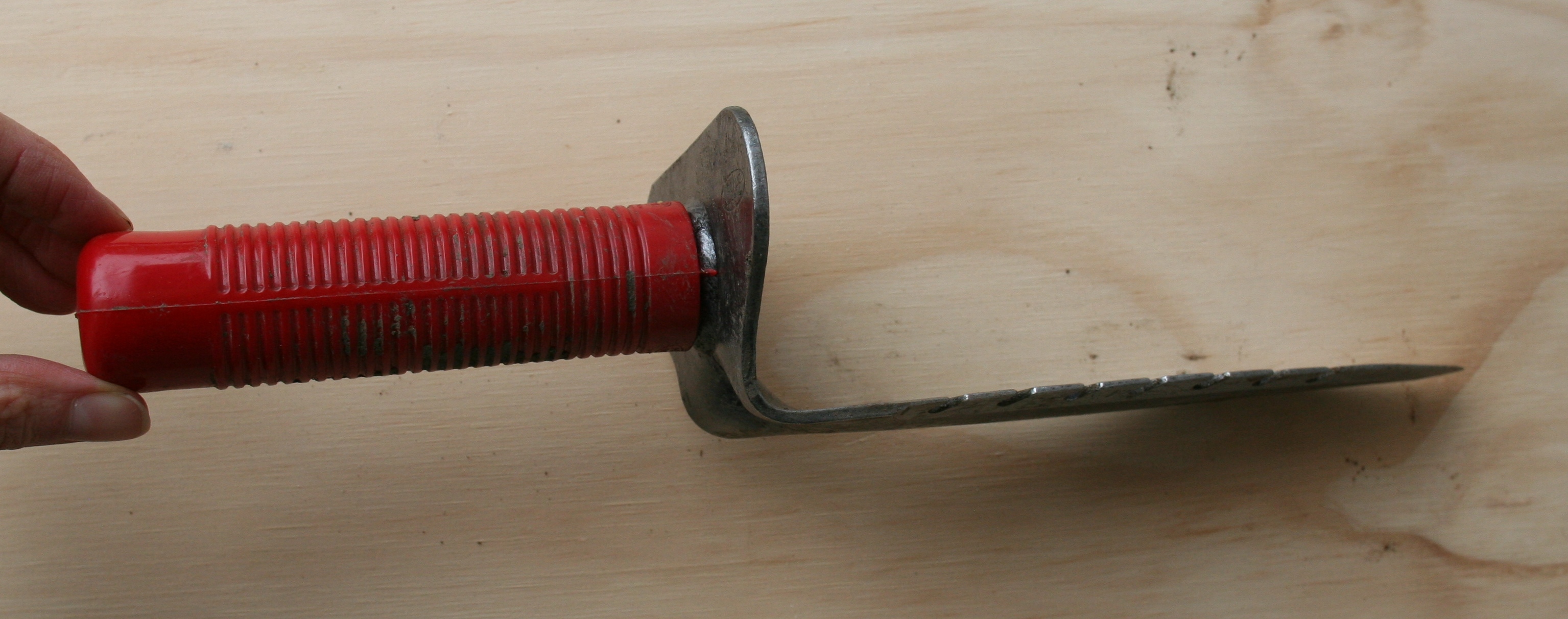
This rugged soil knife has become the top favorite for myself and my landscaping crew. Strangely, I didn’t like the looks of it at first glance. That rectangle of metal between the blade and the handle (they call it a “hand guard”) looked like it was going to get in my way. And before I actually tried it, I didn’t care for the wide teeth on the blade as they looked like they’d snag on things and be hard to sharpen.
Boy was I ever wrong. I’m glad I tested it, because from day one, it became one of those tools everyone on the team reached for. I had to fight to get my original back long enough to photograph it.
There are five elements which make the Pro Gardener’s Digging Tool the best soil knife out there:
- · The blade is offset, which gives great leverage when weeding or digging. Instead of having the blade shoot straight out from the handle, it is offset from the midline of the blade by about 1.5 inches. You wouldn’t believe how much easier it is to pop weeds out when your tool’s giving you extra leverage.
- · It has a non-slip ridged grip, and the red handle color makes it easy to find in the garden if you drop it.
- · The entire handle is steel with a plasticized coating, so it’s unlikely to come apart or break like pretty much every other soil knife will (in time).
- · Those wide teeth I didn’t like the look of? Man was I mistaken. The downward angle of the teeth lets the blade slice into sod or soil like it’s nothing, or cut away the tightly-wrapped roots on a rootbound shrub when transplanting. You can sharpen the teeth as well, it just takes a little more effort than with the standard Japanese hori-hori with a straight blade.
- · Lastly, the hand guard that I thought would annoy me has actually saved my knuckles on more than one occasion, and my foreman says that he liked how the hand guard let him wedge his hand on the handle really good so he could work more vigorously without his hand slipping off.
- It is also available in a left-handed model with the serration on the left side. This allows left handers to work without the serrated part snagging on weeds when you’re trying to move quickly.
The verdict:
If you’re a professional landscaper, serious gardener, or love having the best tool available, this is my pick. It’s built solidly, has a ridges nonslip handle and that offset blade for leverage, and will let you bust through a variety of tasks with little effort. It is made of nearly-indestructible carbon steel (which on other brands of hori-hori can feel heavy and clunky), but this one still manages to feel lightweight and effortless to use.
The only downside to this tool is the price. At about $60 you’ll be pretty grouchy if you lose it in the compost, but luckily the red handle is pretty easy to find in the garden. Plus, it comes with a sheath that you can wear on your belt or attach to your gardening bucket.
Buy the pro gardener’s digging tool from: Garrett Wade![]()
Second Best: Joshua Roth/ Nisaku/ Green Top/ Tomita Stainless Steel Hori Hori


These four brands of Japanese soil knife are identical as far as I can tell, varying only in the brand name stamped on the blade (GrowTech![]() is the one brand of stainless steel digging tool I would avoid – more on that below). The best thing about this type of soil knife is its simplicity. This is an effective, inoffensive hori-hori that everyone will love. The stainless steel means it is lightweight so less stress on your wrist, the blade has a smooth surface that slices through even compacted clay soil with ease, and it will never rust even if you mistreat it (I have tested this claim – look at that ancient, seven-year-old hori-hori above – still kicking!). The only thing I don’t care for is the rectangular shape of the handle. It’s perfectly comfortable, but not ergonomic, so it’s not the 100% best choice for pros.
is the one brand of stainless steel digging tool I would avoid – more on that below). The best thing about this type of soil knife is its simplicity. This is an effective, inoffensive hori-hori that everyone will love. The stainless steel means it is lightweight so less stress on your wrist, the blade has a smooth surface that slices through even compacted clay soil with ease, and it will never rust even if you mistreat it (I have tested this claim – look at that ancient, seven-year-old hori-hori above – still kicking!). The only thing I don’t care for is the rectangular shape of the handle. It’s perfectly comfortable, but not ergonomic, so it’s not the 100% best choice for pros.
The blade itself has a handy little ruler stamped on one side so you can plant bulbs at the right depth, and both the straight and the serrated blade edges are easy to sharpen as needed. The metal of the blade continues into the handle by 2.25″, and while I kind of wish the metal continued the length of the handle for sturdiness, I have to admit that the blades have never come loose in many years of using these tools professionally and having my crews use them full-time. The blade is held onto the handle with two rivets. (If you tend to use your hori-hori as a hammer, you should be aware that these rivets will eventually come loose with such treatment. Really, get a freakin’ hammer and use your hori-hori as intended!)
If you’re in the market for a Japanese hori-hori, you may have noticed there are two different options for the metal. There is carbon steel, which is heavy and black, and stainless steel, which is lightweight and silver. Here’s the difference between the two:
Stainless steel, my favorite, is:
- · Shiny silver
- · Lightweight (less likely to cause repetitive stress injuries if you garden for a long time)
- · Smooth (muck and mud do not stick to the blade when weeding in winter)
- · Paired with a wood that has a smooth finish on it so it doesn’t collect mud either
- · Easy to sharpen
- · More likely to bend if you use it as a pry bar or hammer (but my Joshua Roth, Nisaku, and Green Top hori-horis have never broken or bent under daily professional landscaping use)
Carbon steel, which I hate in this style of hori hori, is:
- · Matte black
- · Heavy (more likely to cause wrist injury if used for a long time)
- · Rough and has a porous-feeling surface which collects mud and feels harder to push into the soil
- · Paired with a porous, unfinished wooden handle which collects mud and is difficult to clean
- · Harder to sharpen
- · Unlikely to bend or break even if used as a hammer or pry bar
The verdict:
Though this isn’t my favorite hori-hori (I prefer the Garrett Wade one above with the rounded handle and powerful offset blade), if you’re a hori-hori newbie, this is a good one to start with, as it’s a mid-range price (about $35) and you won’t find anything to dislike about it. It’s a comfortable tool that will last a long time. Spray paint the handle a gaudy color so it doesn’t get lost in the garden.
Buy the Joshua Roth/ Nisaku/ Green Top/ Tomita hori-hori from: Amazon.com, or a second seller at Amazon.com (prime)
The Worst: GrowTech Hori-Hori



This is the biggest ripoff going around the garden tool world right now. The GrowTech hori-hori claims to be stainless steel, yet rusts profusely at the first sign of moisture, has a cheap blade that is bent (bent!) to fit properly into the handle, and has a worthless glaze on the wood which wears off in spotty patches. I have managed to break two out of three of the ones I have owned in less than 18 months, and the last is so rusty (see above) that I’d feel like a bad boss handing it out to one of my employees to use.
The problem is, GrowTech hori-horis look like the higher-quality Joshua Roth/ Nisaku/ Green Top hori-horis from a distance. Worse, they’re sold under a number of different names by companies that I usually think of as reputable, such as Gardener’s Supply and ARS. The way you can definitively tell a junky GrowTech one is by looking for a little bend or fold in the metal where it hits the handle. It’s hard to see that in the rusty one above, but if you compare the shape of the GrowTech to the good ones shown above – look right in the spot where the blade meets the handle – you can avoid being fooled by this cheap imitator.
The verdict:
Don’t do it.
Mock the GrowTech hori-hori at: Amazon.com![]()
The “Almost” (best for petite hands): A.M. Leonard Deluxe Stainless Steel Soil Knife

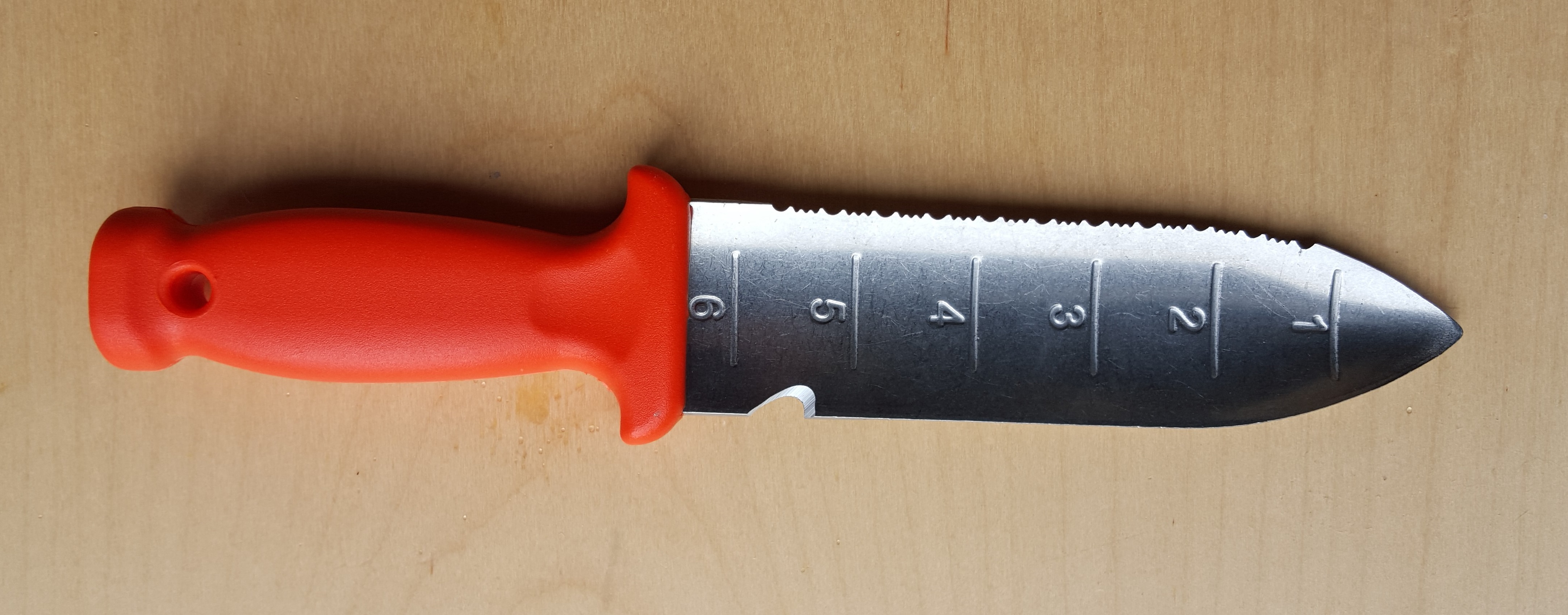
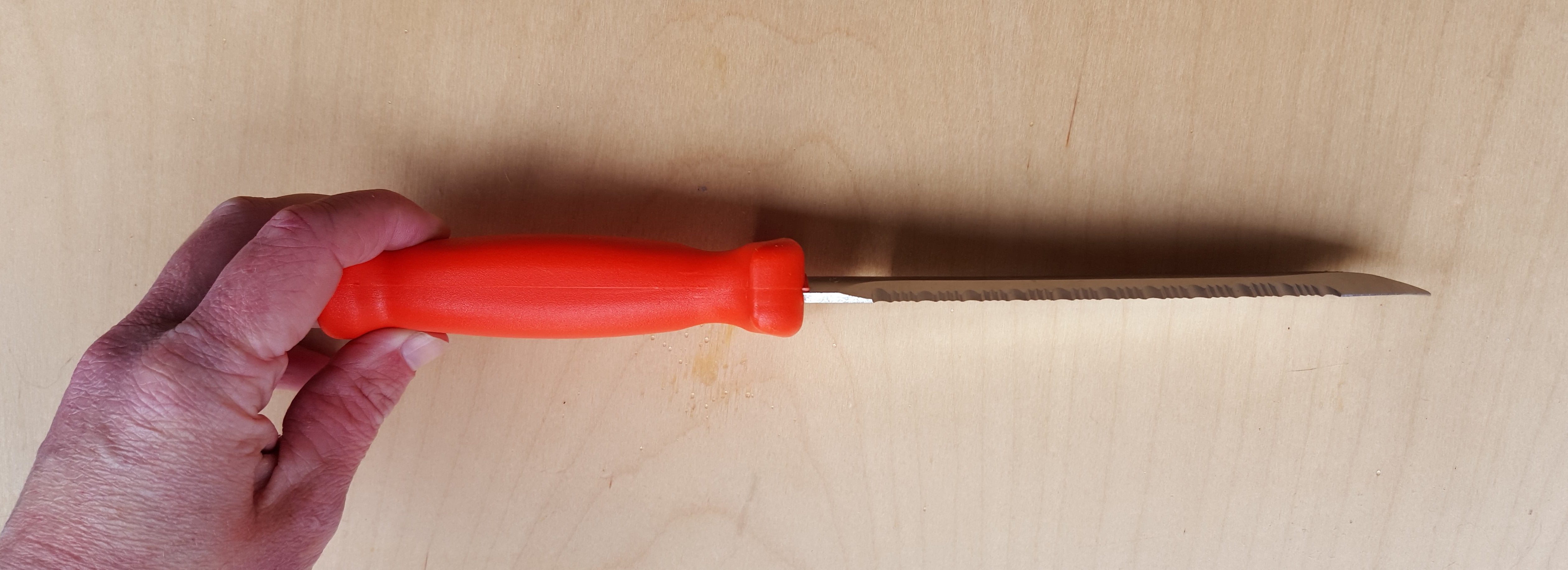
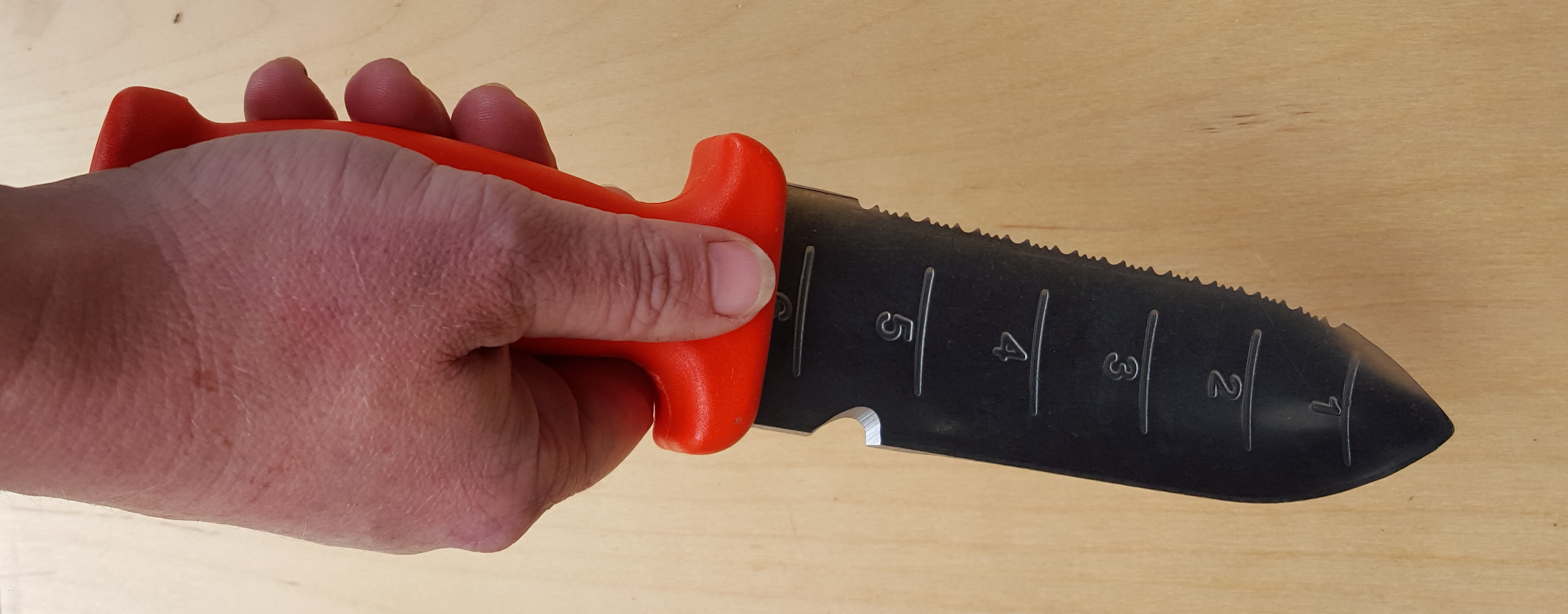
Held by an exceptionally petite-handed person, this soil knife looks proportionate. For my small-glove-sized self, the end of the handle hits me mid-palm, making this an uncomfortable choice.
I actually really love this serviceable soil knife, especially given the reasonable mid-range price tag (about $28). It’s well made, long-lasting, and the handle is pleasantly rounded for a comfortable grip. I also like the style of the serration, which is jagged and sharp and could cut a tomato into slices. It’s very effective at dividing plants and cutting small roots.
Unfortunately, this tool has a fatal flaw for most people. It’s that ridiculously short handle! When held as intended using the thumb rest, it doesn’t even come to the end of my palm, so I found myself using a disproportionate amount of force trying to keep a strong grip on the knife as I worked. Not good. My other quibble is a very small one: you need to buy the sheath separately, if you want one.
Highlights:
- Non-rusting stainless steel
- Lightweight, so less wrist strain
- Jagged “dual cut” serration cuts small roots easily on the up- and the down-stroke, and is sharp enough to cut you, which I consider a bonus (I wear gloves when I work, so a sharp tool is all benefit and no pain)
- Inch markers on the blade, for bulb planting
- Orange handle is easy to find in the garden, and has a comfortable, ergonomic shape (if you have tiny hands)
- A hole in the handle lets you attach a carabiner or cord to the handle
- Twine-cutting notch in the handle, which is somewhat effective at the job indicated
The verdict:
It’s too bad that an otherwise well-designed, low-priced tool has been crippled by a disproportionately short grip area on the handle. I wear a small in gloves, and still found the handle so short that I could not use my palm to steady the handle as I worked. However, if you have petite hands, this is an awesome model that will fit you great and be a long-lasting, comfortable choice.
Buy the Leonard deluxe stainless steel soil knife from: Amazon.com or A.M. Leonard
Another “Almost”: Fiskars Big Grip Soil Knife

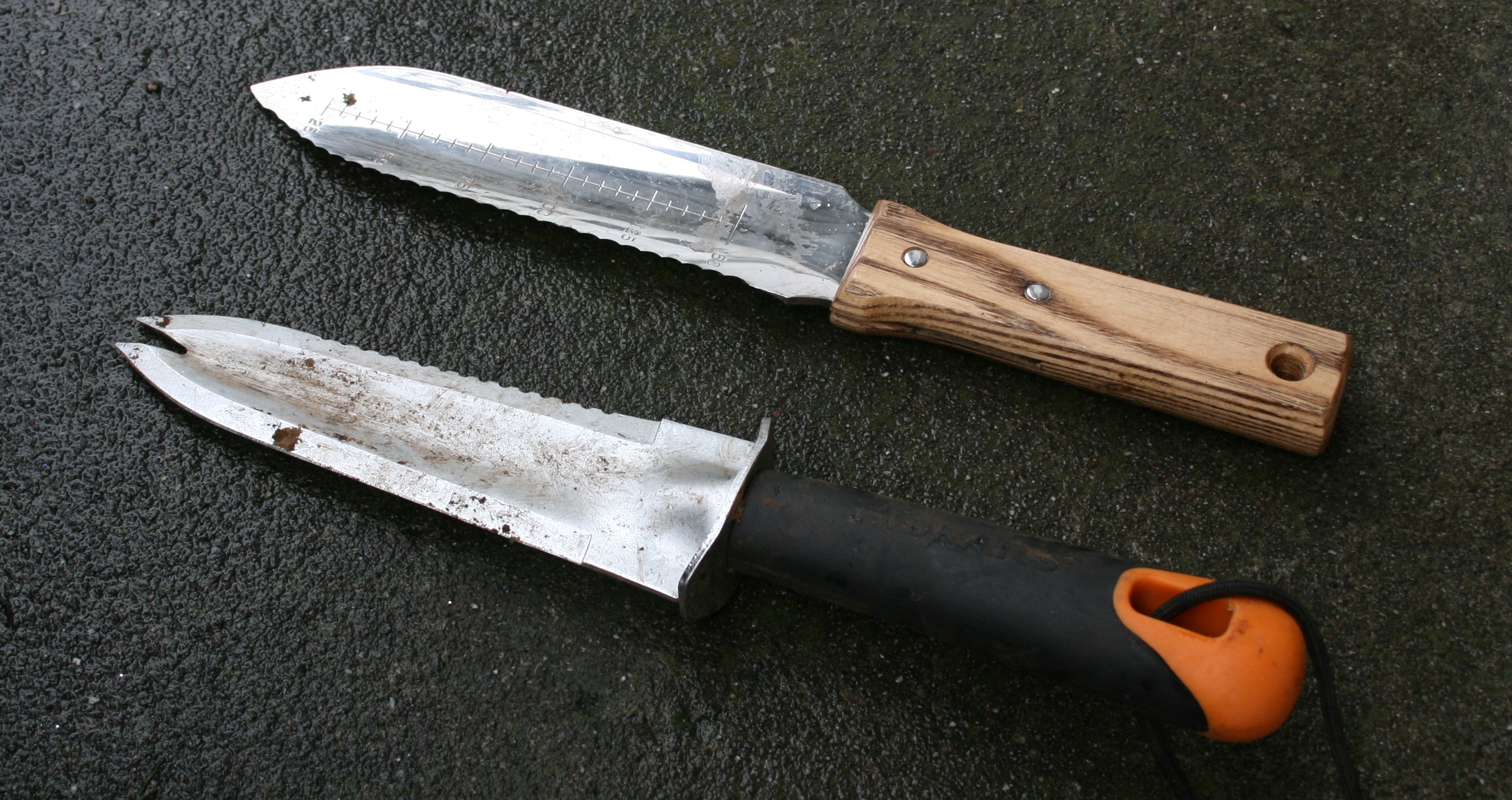
As compared to the Nisaku/ Joshua Roth/ Tomita stainless Hori Hori.
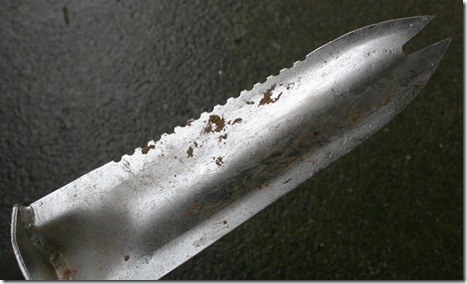
The postage stamp serrated edge on the Fiskars Big Grip Soil Knife.
While I never personally adored using this soil knife, this was the standard soil knife for my landscaping crew for some time, because the tool is dirt cheap ($8) and I never felt compelled to give a lecture when they inevitably got lost. They also have a fat grip that is comfortable and reduces wrist strain.
What I don’t like about it is the dandelion fork at the tip. How often do you need that dandelion fork, and how often does it just get in the way? The dandelion fork part isn’t even all that effective, especially in lawns where the fork catches in the grass and won’t push down. I find myself using more force with this tool just because of that forked tip.
It’s also not going to last a lifetime. While they don’t rust if kept dry and used often, the blade is made of cast aluminum with a rust-resistant coating on it. That’s a far cry from either stainless or carbon steel. And the metal from the blade doesn’t extend all the way through the handle, as you’ll find when it eventually breaks.
The verdict:
For $8, if you’re the type of person who loses your tools in the garden and doesn’t want to have to cry about it, this is a good way of trying out a soil knife and seeing if you end up using it enough to justify the cost of a better one. Just don’t say I didn’t warn you when you find yourself annoyed by that dandelion fork tip.
Buy the Fiskars big grip soil knife from: Amazon.com
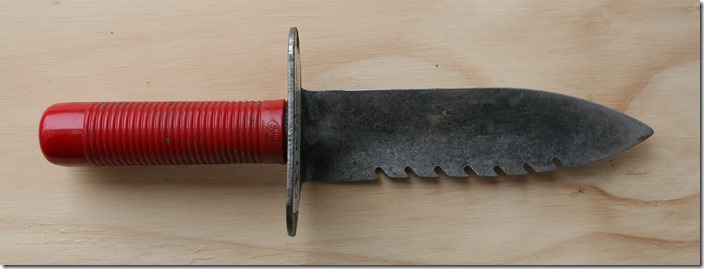
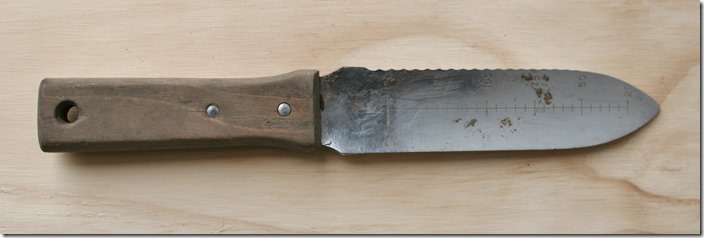


Have you looked at the Hori Hori by Niwaki? http://www.niwaki.com/store/hori-hori/ though one edge has now been turned into an extremely sharp blade. Great for removing dandelions, planting bulbs, weeding etc.
GREAT in every way and I MUCH prefer it to (more expensive) stainless steel.
Yes! They’re nearly identical to the carbon steel Joshua Roth-type, only it looks like the version you are linking to doesn’t have a serrated side, instead having two sharp sides. I have used Niwaki in the past, a stainless version, and found it long-lasting and comparable, again, to the Joshua Roth and other similar brands. I dig Niwaki.
Check out the hori hori at http://www.diggitinc.com. It is made by a mechanical engineer and it is cast stainless steel.
It has a comfortable handle and is very heavy duty. I think you will be hard pressed to find anything better.
Janice, do you represent the company?
Has anyone tried the Sunjoe Model SJHH1901? It’s a carbon steel blade. I just got it and haven’t used it yet!
I’ve owned and lost three. I liked them a lot, especially the strong blade that never bent even when digging out massive pokeweed roots. I drilled a hole in the handle for a lanyard, and painted the handle red for visibility (which ultimately did not keep me from losing them). At the moment I’m using an A.M. Leonard that I borrowed from the park where I volunteer, and have found that I also like the stainless steel blade. It’s sharper and slides into the ground more easily. Plus it is lighter, and I didn’t notice the small handle until now.
But you will find out as you use it whether it is the digger for you.
The Tomita hori hori is also offered with a large rounded polymer handle with handguards.
Yeah, I like the feel of that handle.
Have you seen the new unique tool called the Root Assassin? http://www.rootassassinshovel.com
I sure have, we broke it in about ten minutes of serious digging. 🙂
There is a similar tool made by DeWit called the Shark Toothed Spade or something similar, that is stronger.
I’m thinking of buying hori hori’s for a ways and means fund raiser for garden club members. I’m afraid the Wade Garrets one would be a little steep to use as a fund raiser, Do you have a second one that you would recomend to use as a fund raiser for garden club members, some Master Gardeners? Thanks for your time. Bonnie Brown
What price range are you looking for, Bonnie?
I know this question is from two years ago, but this suggestion might help others. If you mean to sell the tool to members at a markup and made a couple of bucks for the club with each sale, I would suggest the A M Leonard Classic. Unlike the deluxe, it’s not sharp, and to dig weeds or holes it doesn’t need to be. The A. M. Leonard offers a nice price discount if you order six or more. The classic lists for 18.99 at the site (15.99 for six or more). Today, Amazon is asking $28.02– go figure.
She’s gonna kill that chicken!!!
Sorry, I couldn’t resist. Actually, was hoping for reviews of a lot more soil knives than this, but it’s a good start. In metal detecting, the holy grail of digging tools is the Lesche, which looks just like the Garrett Wade, but can be found for about half the price. I’ve had good luck with the Fiskars and an Ames 7-in-1, but haven’t really torture-tested them.
Thank you for this great and in depth review of the Soil Knife. I have been looking to purchase an knife for a couple days now, the Japanese soil knife used to be my favorite. Thank you for all the work you put into this.
I just looked on the Garret Wade website and they don’t have a Japanese knife like the one you pictured. Where can I get one like yours? Amazon has one that looks like your red handled one, made by Lesche, or at least sold by Lesche.
I was using my knife today and the handle broke. Can it be repaired. I love this knife, it’s just old,but, still shining!
I don’t think so. I’m sorry!
My father and his brother were sons of a hardware store owner and farmer. Tools broke often, were repaired. Some of my favorites are the ones with broken handles neatly repaired with duct or electrical tape. Lends character, surprising stability, and love to the tools of my ancestors.
I am left handed. What one would work for me. I have a heavy duty multi purpose one that is curved, meaning the serrated edge would be what I would be usually cutting with. As it can’t be turned over to use.
Acquired my first Hori and love it. I wish I had read your review first, as I like the features of the Garrett Wade from your description. I have made many purchases there and have always been satisfied.
The one I got also came from a very reputable site that sells only high quality tools.
I cannot compare to any other since it is the only one I tried.
http://www.japanwoodworker.com/Product/156234/Heavy-Duty-Garden-Knife.aspx
Pros: very heavy steel, polymer handle that wont warp crack or split, very sharp with one side serrated ( I think saw teeth wood be better, but serrations cut through all but the toughest roots). Came with polymer sheath.
Cons: I think the offset that Garrett Wade has woild improve leveragu (this one is not offset). Also I would prefer more aggressive serrations or better yet, saw on the one edge to cut heavier roots such as shrubbery. All told th0ough I am very satisfied with my purchase. It is on sale the entire month of March.
Ah yes, Nisaku makes one that is nearly identical with a polymer handle that looks very comfortable. They are available on Amazon here: http://www.amazon.com/Nisaku-Outdoor-Mountain-Hiking-No-800/dp/B0033QT8FG
I’ve been really happy with Nisaku, and while the price varies, as of writing it’s 21.99 with free shipping, which is such a good deal that I just snagged one (I like to keep a sample of each type for my crew to test!).
The choice of knife depends on the usage and the soil. In soft loam just about any knife will do. In hard clay soil, my preference is the Survival/Hunting knife offered by Harbor Freight tools. It has a thick, rugged 8-inch stainless steel blade with razor-sharp cutting edge and sawtooth spine. Priced at $9.99 ($7.99 with HF’s frequently offered 20% off coupon), it’s a value for those who don’t need the curved blade or engraved measurements of a hori-hori knife.
I very much agree. Landscaper in Houston. My top digging tools in order of use and importance- fiskars steel shovel, bear grills survival knife, and a double head throwing hatchet. I found both the knife and hatchet on the side of the road and their low cost tempted me to use them in the dirt. Fantastic decision. Now I know about the harbor freight knife I will get one and retire bear grills for what it was intended for!!
Nice write-up Genevive. Soil-seekers landscape, whom I worked for- uses the Joshua Roth version of the hori-hori. It is truly an incredible tool. Don’t weed without a quality hori-hori or you will be wasting your time. I am interested in trying the Garret Wade for the ease of use that you mention. Thanks!
Nice! 🙂 Yes, I heard that the rivets sometimes came off on the stainless Joshua Roth ones when they were misused as hammers (!), but that the carbon steel ones actually held up to such abuse. I have luckily never had anyone ruin a Garret Wade one, and that’s what my entire crew uses now, except for one tiny lady who prefers the one from Am Leonard (which I like quite well for the very petite).
Terrible picks. Why not reviewthe best? Dig Dig, Oakridg Gardens, Greenisory, Garden Guru, and Lausihay make great Hori Hori digging tools.
Thank you very much for the information! You’ve really helped me make a purchasing decision.
I just purchased my first hori-hori and I don’t know how I lived without one all of these years. My pick was the Truly Garden that I found on Amazon.com. Beautiful tool with a high quality leather sheath and complimentary sharpening stone. I am extremely happy with this knife as the SS blade runs the entire length of the wood handle. Very sturdy so far.
The top rated Pro Gardener’s Digging Tool said at the bottom there is a left-handed version. But I can only find one kind, all pointing to the same GW site link. Do you know who actually makes this tool? I called Garret Wade and the rep was not even aware that serration means hand-bias! I need a left handed hori-hori. Any suggestions? Thank-you.
Try this one 🙂
https://www.amazon.com/Lesche-Digging-Tool-Cutter-Left/dp/B00AXB89PY/
I have always found a steak knife works well and always available.
hey, I’m a landscaper from alberta, and I was wondering if you knew anything about banana knives, I use these when I lay sod, and ive been trying to find them with copper blades the steel ones don’t keep well
I just broke a Fiskars knife that I bought at the Home Depot. I was just discovering how awesome the tool was, and wondering where this tool had been all my life, when the blade just snapped. I was prying on a root/rock. I blame cheap steel, Fiskars should know better.
Avoid Model # 370880-1001 Internet #300374030 Store SKU #1002114927
I can attest to the same experience with the Fiskars knife. The blade is cheaply welded to the handle shank. Mine disappointingly snapped under minimal pressure. I discovered that, despite taking very good care of it, some moisture had accumulated where the blade was welded to the handle shank, and the resulting rust weakened the joint. 🙁 Would definitely NOT recommend.
Interesting article. I ended up getting the Nisaku NJP650 and I quite like it. I’ve seen a lot of talk about having a full tang and I could see how it would balance the weight of the knife better, but it seems the original Japanese design is half tang. Besides, having a garden knife that naturally wants to point down seems like a desired feature for most of my needs.
I will say, personally, I *really* love the AM Leonard soil knife. I actually *found* my first one at a jobsite, I removed two dumpster-fulls of bindweed infested mulch that had been sitting for years and it was underneath it all. So smitten, I bought my own (with a pink handle so I could tell which one was mine, my employer had their own already but I never used it), and I live/die by the thing.
I have huge hands- I have a hard time finding gloves that fit me, so I’m shocked to hear you find the handle size too small. It’s not huge, but it’s my weapon of choice. I just planted 2000 crocus bulbs in various lawns with it, and had a friend helping with the other one, absolutely love it.
That being said, I was intrigued by this Garrett Wade tool… but I looked at it on their site, looked around the site and got a little bitter. $50 on sale seems obscene for that tool (and the comical Hunte Wilde bicycle handlebar grip used as a handle… the same grips that were on every cheap ’60s-70s department store bike, I’m actually impressed they still make the damn things. They’re immediately identifiable, I have bins of them). Garrett Wade seems like a company that just buys others’ products and slaps their name on it to charge a premium, and I’m super unimpressed by that stuff, so with some digging, I’m pretty sure the original manufacturer is Lesche and they call it the Digging Tool & Sod Cutter. They’re out there for $38 on Amazon and a few bucks less in other places and available with the teeth on right and left side for left handed gardeners as well.
Thank you for this super informative and useful review! For a newbie hobby gardener, what do you think about the importance of having a bolster/finger guard? And any thoughts on the merits of a full-tang vs. half-tang blade (assuming the hori hori won’t be used like a hammer)?
For example, here’s one I found that seems nice but I don’t know if the extra features (bolster & full tang) are actually beneficial / worth it over the Nisaku you recommended. Thanks!
https://shop.thecelticfarm.com/collections/gifts-for-the-gardener/products/hori-hori-japanese-gardeners-knife
Thanks to your review I got the Garrett-Wade. It is far and away my favorite garden tool, ever! My husband has gotten me different hori-horis (he’s a tool nut) and I’ve tried them, but the Garrett-Wade is the one I use all the time. The others just don’t compare in comfort of use. I do think it’s because the blade is offset.